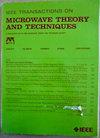UWB Transparent Metamaterial Absorber With Optimally Patterned Gold Nanolayer
IF 4.1
1区 工程技术
Q2 ENGINEERING, ELECTRICAL & ELECTRONIC
IEEE Transactions on Microwave Theory and Techniques
Pub Date : 2024-10-01
DOI:10.1109/TMTT.2024.3462965
引用次数: 0
Abstract
A novel thin, optically transparent microwave metamaterial absorber (TMMA) is presented. The proposed structure utilizes a 3-mm-thick polycarbonate (PC) main substrate coated on both sides with 8-nm-thick gold thin films deposited via thermal evaporation. To achieve maximum absorption bandwidth, polarization insensitivity, and angular stability, the unit cell of the TMMA is optimized through a pixelation and binary optimization technique. This process results in an optimal pattern of gold nanolayer on the upper surface of the substrate. The resulting periodic pattern is transferred using optical lithography. The bottom gold film acts as the electrical ground plane. An additional 3-mm-thick PC superstrate is then incorporated to improve impedance matching and protect the coating of the main substrate. Comprehensive full-wave electromagnetic simulations are employed to assess the absorption performance. The design is subsequently validated through sample fabrication and experimental measurements. The proposed TMMA exhibits over 90% absorption within an ultrawideband (UWB) range of 5.1–25.2 GHz while maintaining an average optical transparency of approximately 70%. The symmetrical design additionally offers wide angular stability and minimal polarization sensitivity.求助全文
约1分钟内获得全文
求助全文
来源期刊

IEEE Transactions on Microwave Theory and Techniques
工程技术-工程:电子与电气
CiteScore
8.60
自引率
18.60%
发文量
486
审稿时长
6 months
期刊介绍:
The IEEE Transactions on Microwave Theory and Techniques focuses on that part of engineering and theory associated with microwave/millimeter-wave components, devices, circuits, and systems involving the generation, modulation, demodulation, control, transmission, and detection of microwave signals. This includes scientific, technical, and industrial, activities. Microwave theory and techniques relates to electromagnetic waves usually in the frequency region between a few MHz and a THz; other spectral regions and wave types are included within the scope of the Society whenever basic microwave theory and techniques can yield useful results. Generally, this occurs in the theory of wave propagation in structures with dimensions comparable to a wavelength, and in the related techniques for analysis and design.
 求助内容:
求助内容: 应助结果提醒方式:
应助结果提醒方式:


